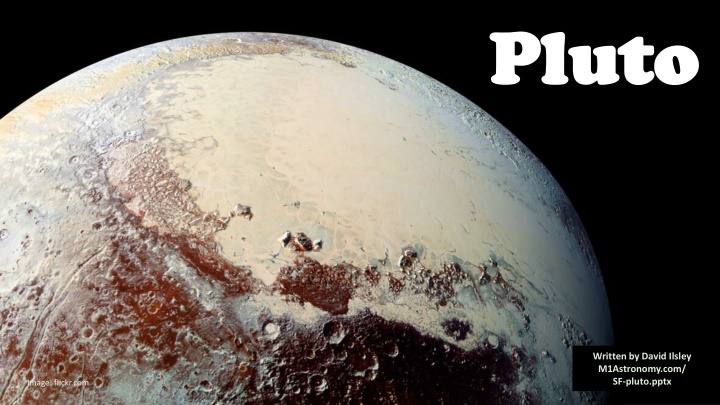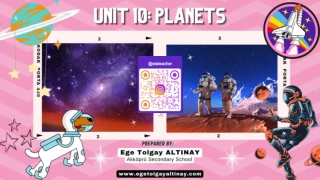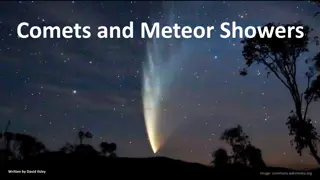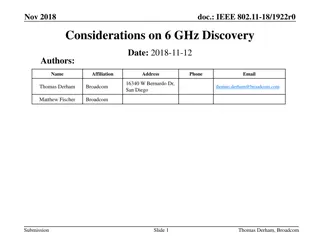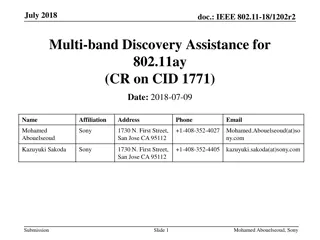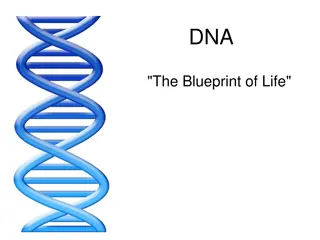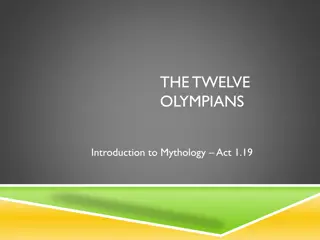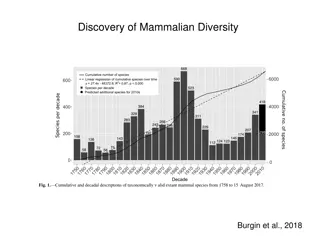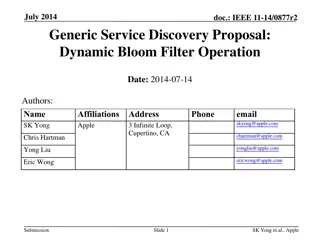The Fascinating Story of Pluto's Discovery and Characteristics
Pluto, once considered the outermost planet, is located 6 billion kilometers from the Sun and has a fascinating history surrounding its discovery. From its extreme cold temperatures to the lengthy time light takes to reach it, Pluto continues to captivate astronomers and enthusiasts alike. Learn about its initial observations, the search for "Planet X," and the eventual discovery by Clive Tombaugh in 1930.
Download Presentation

Please find below an Image/Link to download the presentation.
The content on the website is provided AS IS for your information and personal use only. It may not be sold, licensed, or shared on other websites without obtaining consent from the author.If you encounter any issues during the download, it is possible that the publisher has removed the file from their server.
You are allowed to download the files provided on this website for personal or commercial use, subject to the condition that they are used lawfully. All files are the property of their respective owners.
The content on the website is provided AS IS for your information and personal use only. It may not be sold, licensed, or shared on other websites without obtaining consent from the author.
E N D
Presentation Transcript
Pluto Pluto Written by David Ilsley M1Astronomy.com/ SF-pluto.pptx Image: flickr.com
Pluto was once the outermost planet. It is 6 billion kilometres from the Sun, 40 times as far as the Earth. From Pluto, the Sun would appear as a very bright star just a point of light, but still very much brighter than the full moon on Earth. But it wouldn t feel very warm. In fact the average temperature on Pluto is about 40 K ( 230 C), though it varies about 10 degrees either side of that. At those temperatures oxygen and nitrogen are frozen. Light takes 6 hours to get from the Sun to Pluto, compared to 8 minutes for Earth. Image: flickr.com
Five planets were known to the ancients Mercury, Venus, Mars, Jupiter and Saturn. Of course, they didn t realise that Earth was a planet too. Uranus is just visible to the naked eye, but wasn t discovered until 1781 when William Herschel spotted it with his telescope and noticed that it moved from night to night against the background stars. Neptune is not visible to the naked eye and was discovered in 1846 because of it gravitational influence on Uranus, causing it to orbit slightly differently from what was predicted. Image: commons.wikimedia.org
Are the planets to scale? Image: pixabay.com
In the late 19th Century, observations of Neptune suggested that its orbit was being perturbed by yet another planet. In 1894, Percival Lowell established the Lowell Observatory in Flagstaff, Arizona. And in 1906 he started a search for the planet, which he called Planet X. He died in 1916, not having found it. Unbeknown to him though, the observatory had captured two feint images of Pluto in 1915, though they weren t recognised for what they were. Image: commons.wikimedia.org In fact, more than a dozen photos taken before the discovery were later found to contain images of Pluto.
The search resumed in 1929 with the task assigned to 23-year-old Clive Tombaugh. He took thousands of photos of different parts of the sky around the place it was predicted to be. Each photo was repeated a few days later. The two versions were then looked at with a machine that could flick back and forth between the two photos. That way it was easy to see if anything moved. He spotted the planet on 18 February 1930.
The photo pair from which Pluto was discovered. Image: Fair use, https://en.wikipedia.org/w/index.php?curid=27861619
Having found it, Lowell Observatory had the right to name it. Over 1000 suggestions came in from all over the world. The name Pluto was suggested by Venetia Burney, an 11-year-old schoolgirl in Oxford, England. The name continued the trend by which Uranus and Neptune had been named after Greek and Roman gods. Uranus was the Greek god of the sky, Neptune was the Roman god of the sea, Pluto was the Roman god of the underworld. Venetia died in 2009, 3 years after Pluto s demotion.
In early photos Pluto was a tiny spot, barely visible amongst the background stars. It s magnitude averages about 15, some 5 000 times dimmer than the dimmest stars that can be seen with the naked eye. Later photos from Earth were better, though even by 2012, the image to the right, showing Pluto and its moon Charon was the best available. Image: Fair use, https://en.wikipedia.org/w/index.php?curid=27861619
The Hubble Space Telescope did a little better, showing some surface detail. Image:flickr.com
Image: pixabay.com But it wasn t until New Horizons flew past Pluto in July 2015 that we got good detailed photos along with other measurements. It turned out to be much more interesting than anyone expected.
The white plains are made of nitrogen ice with traces of methane and carbon monoxide. The white plains have no craters, suggesting that the surface is young. In fact it is only about 200 000 years old. It shows signs of glacial flow: the nitrogen on Pluto flows in a similar way to the ice in Antarctica. The mountainous areas are made of water ice. Water ice on Pluto would be much harder than nitrogen ice and seems to remain fairly rigid for long periods of time. Hence the mountainous areas tend to have quite a few craters. Image:flickr.com
The colours on the surface are caused by organic compounds, in particular tholins which are produced by reactions between nitrogen, methane and other gases. These organic molecules could be the precursors of life, though, at the prevailing temperature of about 230 C (40 K), any generation of life would be very slow and probably impossible. Similar tholins are present on other solar system bodies, Saturn s moon Titan in particular. Image:flickr.com
Pluto has a very thin atmosphere containing nitrogen with lesser methane and carbon monoxide, the same molecules that are in the nitrogen ice plains. The ices tend to evaporate more producing a thicker atmosphere when Pluto is closer to the Sun (and therefore warmer) and solidify more, making the atmosphere thinner when Pluto is further away from the Sun. Image:flickr.com
Pluto would have condensed when the solar system first formed 4.5 billion years ago from a cloud of ice and dust (mostly silicates). It is thought that internal heating from radioactive decay would have made it warm enough inside for the water ice to melt, allowing the dust to settle towards the centre forming a rocky core. The mantle would have been mostly liquid water at depth and water ice closer to the surface. There could still be liquid water 100 km or so down. Pluto s radius is 1183 km. Image By PlanetUser - Own work, CC BY-SA 4.0, https://commons.wikimedia.org/w/index.php?curid=80102848
Pluto is now known to have 5 moons: Charon, half the diameter of Pluto and 4 smaller moons, Styx, Nix, Kerberos and Hydra. Pluto and Charon always keep the same faces towards each other. Image: commons.Wikimedia.org
Pluto orbits the Sun in 248 years. Its orbit is quite eccentric ranging from 30 AU to 49 AU from the sun. At perihelion (the closest it gets to the Sun), it is actually slightly closer than Neptune. Also, the plane of its orbit is inclined (tilted) about 17 from the plane of the orbit of the planets. Pluto is in orbital resonance with Neptune, meaning that it does exactly 2 orbits each time Neptune does 3. Image: commons.Wikimedia.org
When Pluto was discovered, it was considered the ninth planet and this remained the case for many years. From 1992 onwards, however, quite a few other bodies similar in size to Pluto were found in similar orbits. Image: en.wikipedia.org
Along with a multitude of smaller bodies, these constitute the Kuiper Belt, lying between about 30 AU and 50 AU from the Sun. The Kuiper Belt is similar to the Asteroid Belt, though about 20 times wider and maybe 100 times as massive. Astronomers were presented with a dilemma. If Pluto was to be a planet, then numerous other bodies of the Kuiper Belt should also be planets. And so should several of the asteroids which are of comparable size. The asteroids Ceres, Pallas, Juno and Vesta were initially classed as planets until it was realised that they were just four of thousands of asteroids. Then they were reclassified as asteroids.
From 2000 to 2006, this issue was debated by astronomers. Then, in 2006, the International Astronomical Union resolved to define a planet as a body that: 1. orbited a star, 2. was massive enough for its own gravity to make it spherical, 3. had cleared the debris from the neighbourhood of its orbit. Pluto satisfies 1 and 2, but not 3: the Kuiper Belt still contains a lot of debris. Bodies that satisfy just 1 and 2 became dwarf planets. Pluto, several other Kuiper Belt bodies and the asteroid Ceres all became dwarf planets.
This upset much of the worlds population and, suddenly, Pluto was everyone s favourite planet rejected by mean uncaring astronomers. Some astronomers even received death threats from irate Pluto lovers. However, it may be of some consolation to think that a dwarf fruit tree is still a fruit tree and a dwarf rabbit is still a rabbit. So a dwarf planet is really still a planet. Maybe. Image: pixabay.com
There used to be a mnemonic for remembering the order of the planets: My Very Elderly Mother Just Sat Up Near Pluto. Now this mnemonic no longer works. As someone said: My Very Easy Memory Jingle Seems Useless Now.
